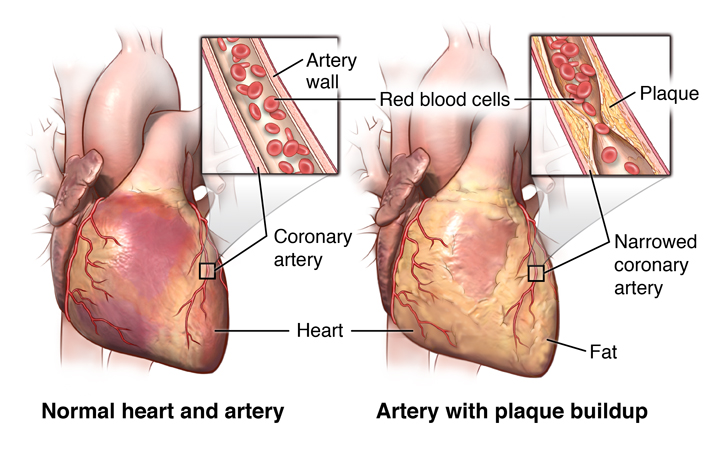What is a heart attack?
A heart attack (myocardial infarction) happens when one or more areas of the heart muscle don't get enough oxygen. This happens when blood flow to the heart muscle is blocked.

The blockage is caused by a buildup of plaque in the arteries (atherosclerosis). Plaque is made of cholesterol and other substances. When plaque breaks (ruptures), a blood clot quickly forms. The blood clot is the actual cause of the heart attack.
If the blood and oxygen supply is cut off, muscle cells of the heart begin to suffer damage and start to die. Irreversible damage begins within 30 minutes of blockage. As a result, the heart muscle affected by the lack of oxygen no longer works as it should.
Risk factors for heart attack
Take the Heart Health Risk Assessment
There are two types of risk factors for heart attack. A risk factor increases your chance of developing a disease. Some can be changed, others cannot. Risk factors for heart attack that you can’t change are called inherited or genetic and include:
- People with inherited high blood pressure (hypertension)
- People with inherited low levels of HDL cholesterol, high levels of LDL cholesterol or high levels of triglycerides
- People with a family history of heart disease (especially true if the heart disease started before age 55)
- Older men and women
- People with type 1 diabetes
- Women who have gone through menopause (Generally, men are at risk at a younger age than women. After menopause, women are equally at risk.)
Risk factors for heart attack that you can change are called acquired and include:
- People with acquired high blood pressure (hypertension)
- People with acquired low levels of HDL cholesterol, high levels of LDL cholesterol or high levels of triglycerides
- Smokers
- People who are under a lot of stress
- People who drink too much alcohol
- People who lead a sedentary lifestyle
- People overweight by 30 percent or more
- People who eat a diet high in saturated fat
- People with type 2 diabetes
A heart attack can happen to anyone. When you take the time to learn which risk factors apply to you, you can take steps to eliminate or reduce them.
Managing risk factors
Here are ways to manage your risks for a heart attack:
- Look at which risk factors apply to you, then take steps to eliminate or reduce them.
- Learn about high blood pressure and high cholesterol levels. These may be "silent killers," meaning you can have them and not know it.
- Change risk factors that aren't inherited by making lifestyle changes. Talk with your health care provider to find out how to do so.
- Talk with your health care provider to find out if you have risk factors and the best ways to minimize them.
Warning signs of a heart attack
The following are the most common symptoms of a heart attack. But each person may have slightly different symptoms.
- Severe pressure, fullness, squeezing, pain or discomfort in the center of the chest that lasts for more than a few minutes
- Pain or discomfort that spreads to the shoulders, neck, arms or jaw
- Chest pain that gets worse
- Chest pain that doesn't get better with rest or by taking nitroglycerin
- Chest pain that happens along with any of these symptoms:
- Sweating, cool, clammy skin, or paleness
- Shortness of breath
- Nausea or vomiting
- Dizziness or fainting
- Unexplained weakness or fatigue
- Rapid or irregular pulse
Women can experience different symptoms than men. They most likely will have chest pain or discomfort. But women are more likely to experience additional symptoms, such as shortness of breath, nausea/vomiting, and back or jaw pain.
Although chest pain is the key warning sign of a heart attack, it may be confused with other conditions. These include heartburn, indigestion, pleurisy, pneumonia, and tenderness of the cartilage that attaches the front of the ribs to the breastbone.
Responding to warning signs
Call 911 if you or someone you know has any of the above warning signs.
Treatment for a heart attack
At UMass Memorial Health, we understand that seconds matter after a heart attack. Our community hospitals, emergency medical services and UMass Memorial Medical Center in Worcester work together so patients receive fast, appropriate emergency care.
 Working with our community, the Medical Center’s "door-to-balloon" time (the length of time from when a heart attack patient enters our Emergency Department to when his/her blocked artery is opened in our cardiac catheterization lab) averages 60 minutes, significantly below the standard of 90 minutes set by The Joint Commission.
Working with our community, the Medical Center’s "door-to-balloon" time (the length of time from when a heart attack patient enters our Emergency Department to when his/her blocked artery is opened in our cardiac catheterization lab) averages 60 minutes, significantly below the standard of 90 minutes set by The Joint Commission.
You will receive outstanding cardiology care at all our hospitals and physician offices. That makes it convenient for you to get the heart care you need, close to home. If you need more specialized cardiac care, you have access to services at our Heart and Vascular Center, located at our Medical Center in Worcester, MA. From cardiac catheterization to cardiac rehabilitation, UMass Memorial Health can help.
